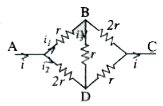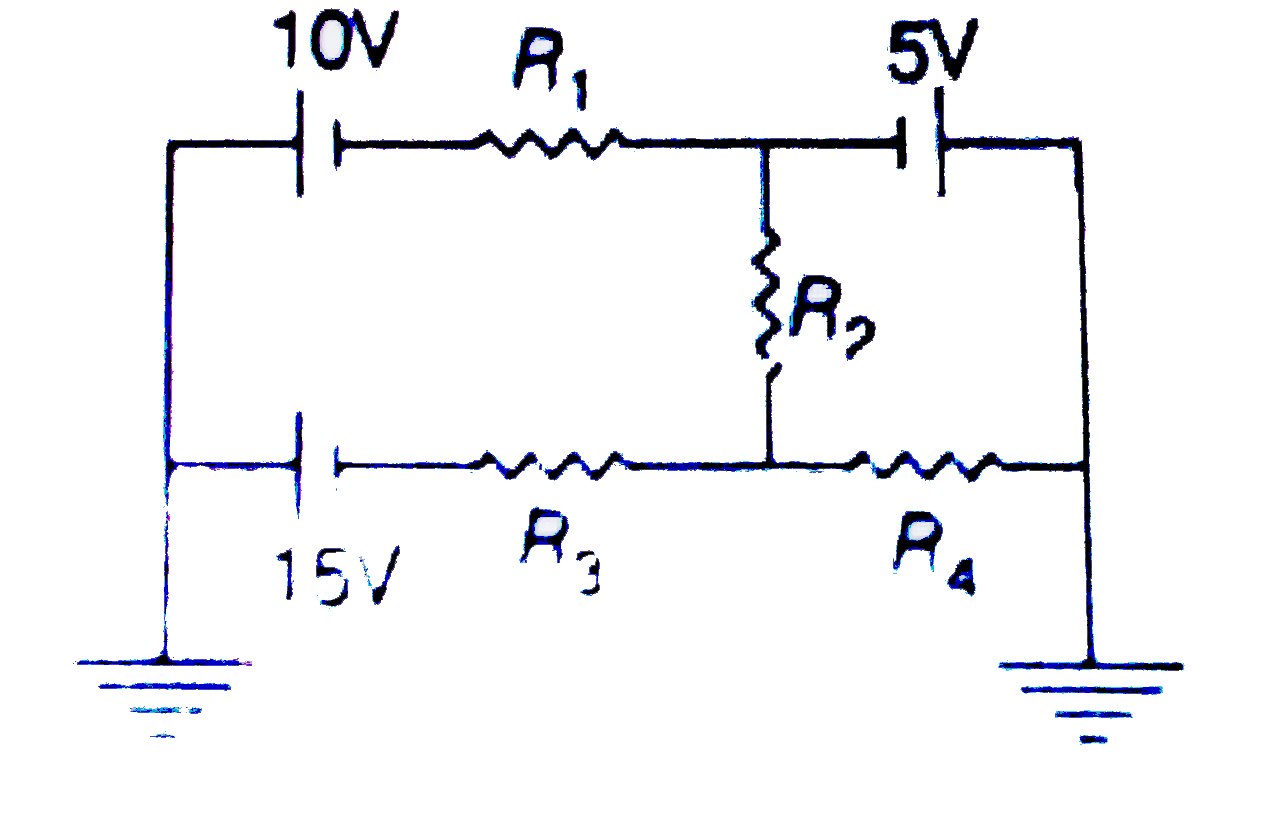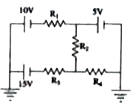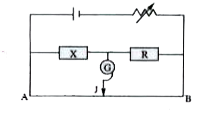LECTURE SHEET (EXERCISE-VI LEVEL- II (ADVANCED) (Matrix Matching Type Questions)) from AAKASH SERIES CURRENT ELECTRICITY for Class 12
| Class 12 | PHYSICS |
| Chapter | CURRENT ELECTRICITY |
| AAKASH SERIES | LECTURE SHEET (EXERCISE-VI LEVEL- II (ADVANCED) (Matrix Matching Type Questions)) |
| Medium | English |
| Academic Year | 2023-2024 |
Question 3
Positive and negative ions are produced in the atmosphere due to cosmic rays from space and also due to radioactive elements in the soil. In some region in the atmosphere, the electric field strength is 100V/m in the vertically downward direction. This field exerts force on the positive and negative ions in the given region in atmosphere. As a result, positive ions, having a density 500/cm3 drift downward while negative ions, having a density 300/cm3 drift upward. All these ions are singly charged. It is observed that the conductivity in the given region is 4×10−13(Ω−m)−1. Find the average speed of ions, assuming it to be the same for positive and negative ions.View SolutionQuestion 8
Potential difference that is applied across a conductor of resistance .R. varies with time .t. according to the equation V(t)=V0e−t/z where z is a constant that has dimonsions of time. Obviously, the applied potential difference decreases exponentially with time. Charge that passes through any fixed observation point within the conductor between t=0 and t=z will beView SolutionQuestion 9
An electric current passes through a circuit containing two wires of the same material connected in parallel. If the lengths of the wires are in the ratio of 4/3 and radius of the wires are in the ratio of 2/3, then the ratio of the currents passing through the wires will be : View SolutionQuestion 28
A coaxial cable is made up of two conductors. The inner conductor is solid is of radius R1 and the outer coductor is hollow of inner radius R2 and outer radius R3 . The space between the conductors are carrying currents of equal magnitudes and in oppsite direactions. then the variation of magnetic field with distance form the axis is best plotted as :
 View Solution
View SolutionQuestion 32
A thin wire of length L and cross-sectional area A oriented in the x-direction is made up of an ohmic material whose resistivity varies along the wire according to the empirical law ρ=ρ0e−x/lL
(i) Determine how the field with in wire varies with position if the end at x=0 is at potential V0 greater than the end at x=L.
(ii) How does potential varies as you move along the wire ?
(Iii) What is resistance of the wire ? View SolutionQuestion 39
Passage :
The thermal coefficient of resistivity is given by α=1ρdρdT where ρ is resistivity at a temperature T. α is not constant, rather varies as α=−nT, where T is temperature in Kelvin and n is a constant. For carbon α=−0.0005K−1andρ=3.5×10−5(Ω−m)at27∘C
Find the value of .n. for carbonView SolutionQuestion 40
Passage :
The thermal coefficient of resistivity is given by α=1ρdρdT where ρ is resistivity at a temperature T. α is not constant, rather varies as α=−nT, where T is temperature in Kelvin and n is a constant. For carbon α=−0.0005K−1andρ=3.5×10−5(Ω−m)at27∘C
Find the value of .n. for carbonView SolutionQuestion 42
The emf of a storage battery is 90V before charging and 100V after charging. When charging began the current was 10A. What is the current at the end of charging if the internal resistance of the storge battery during the whole process of charging may be taken as constant and equal to 2Ω?View SolutionQuestion 44
Fig. shows a part of circuit. When a current I = 1.5 A passes through it in the direction shown, power delivered to it (section XY) is 75W. Potential difference between X and Y and also the emf E of the cell are respectively (assume that the cell has a negligible internal resistance)
 View Solution
View SolutionQuestion 49
A long solenoid having n = 200 turns per metre has a circular cross-section of radius a1=1cm. A circular conducting loop of radius a2=4cm and resistance R=5(Ω) encircles the solenoid such that the centre of circular loop coincides with the midpoint of the axial line of the solenoid and they have the same axis as shown in Fig.

A current 't' in the solenoid results in magnetic field along its axis with magnitude B=(μ)ni at points well inside the solenoid on its axis. We can neglect the insignificant field outside the solenoid. This results in a magnetic flux (ϕ)B through the circular loop. If the current in the winding of solenoid is changed, it will also change the magnetic field B=(μ)0ni and hence also the magnetic flux through the circular loop. Obvisouly, it will result in an induced emf or induced electric field in the circular loop and an induced current will appear in the loop. Let current in the winding of solenoid be reduced at a rate of 75A/sec.
When the current in the solenoid becomes zero so that external magnetic field for the loop stops changing, current in the loop will follow a differenctial equation given by [You may use an approximation that field at all points in the area of loop is the same as at the centre View SolutionQuestion 50
The two batteries of emf E1 and E2 having internal resistances r1 and r2 respectively are connected in series to an external resistor R. Both the batteries are gatting discharged. The above described combination of these two batteries has to produce a weaker current then when any one of the battery is connected to same resistor. For this requirement to be fulfilled.View SolutionQuestion 54
A 6-volt battery of negligible internal resistance is connected across a uniform wire AB of length 100cm. The positive terminal of another battery of emf 4V and internal resistance 1(Ω)is joined to the point A as shown in figure.Take the potential at B to be zero. (a) What are the potentials at the poits A and C ? (b) At which point D of the wire AB, the potential is equal to the potential at C?(c ) If the point C and D are connected by a wire, what will be the current through it ? (d) If the 4V battery is replaced by 7.5V battery,wht would be the answer of parts (a) and (b) ?
 View Solution
View SolutionQuestion 55
A 6-volt battery of negligible internal resistance is connected across a uniform wire AB of length 100cm. The positive terminal of another battery of emf 4V and internal resistance 1(Ω)is joined to the point A as shown in figure.Take the potential at B to be zero. (a) What are the potentials at the poits A and C ? (b) At which point D of the wire AB, the potential is equal to the potential at C?(c ) If the point C and D are connected by a wire, what will be the current through it ? (d) If the 4V battery is replaced by 7.5V battery,wht would be the answer of parts (a) and (b) ?
 View Solution
View SolutionQuestion 71
A moving coil galvanometer of resistance 20Ω gives a full scale deflection when a current of 1mA is passed through it. It is to be converted into an ammeter reading 20A on full scale. But the shunt of 0.005Ω only is available. What resistance should be connected in series with the galvanometer coil?View SolutionQuestion 72
An ammeter A of finite resistance and a resistor R are joined in series to and ideal cell C. A potentiometer P is joined in parallel to R. The ammeter reading is I0 and the potentiometer reading is V0. P is now replaced by a voltmeter of finite resistance. The ammeter reading now is I and the voltmeter reading is V. Then
 View Solution
View SolutionQuestion 75
shows a circuit used in an experiment to detrmine the emf and interanl resistance of the battery C. A graph was plotted of the potential difference V between the terminals of the battery against the current I, which was varied by adjusting the rheostat. The graph is shown in x and y are the intercepts of the graph with the axes as shown. What is the internal resistance of the battery? View Solution
View SolutionQuestion 76
A galvanometer has a current sensitivity of 1 mA per division. A variable shunt is connected across the galvanometer and the combination is put in series with a resistance of 500Ω and cell of internal resistance 1Ω. It gives a deflection of 5 division for shunt of 5 ohm and 20 division for shunt of 25 ohm. The emf of cell isView SolutionQuestion 79

A potentiometer wire AB as shown in 40 cm long of resistance 50Ω/m free end of an ideal galvanometer is touching the potentiometer wire with the help of a jockey. What should be the velocity of the jockey as a function of time so that potential difference across the galvanometer is varying with time as (2sinπt)VView SolutionQuestion 80
A 6V battery of internal resistance 1Ω is connected across a uniform wire AB of length 100 cm. The positive terminal of another battery of E.M.F 4V and internal resistance 1Ω is joined to the point A as shown. The distance of point P from A is α×10cm. Find the value of α, for which there is no current through the galvanometer. (resistance of AB wire is 5Ω)
 View Solution
View SolutionQuestion 92
The current I through a rod of a certain metallic oxide is given by I=0.2V1/2 , where V is the potential difference cross it. The rod is connected in series with a resistance to a 6 volt battery of negligible internal resistance. What value should the series resistance have so that :
A) the current in the circuit is 0.4 A
B) the power dissipated in the rod is twice that dissipated in the resistance.View Solution
All Exercises from AAKASH SERIES Class 12 PHYSICS CURRENT ELECTRICITY
- EXERCISE - IA
- EXERCISE - IB
- LECTURE SHEET (EXERCISE- II LEVEL- II (ADVANCED) (LINKED COMPREHENSION TYPE QUESTIONS))
- LECTURE SHEET (EXERCISE- II LEVEL- II (ADVANCED) (MATRIX MATCHING TYPE QUESTIONS))
- LECTURE SHEET (EXERCISE- II LEVEL- II (ADVANCED) (STRAIGHT OBJECTIVE TYPE QUESTIONS))
- LECTURE SHEET (EXERCISE- II LEVEL-I (MAIN) (STRAIGHT OBJECTIVE TYPE QUESTIONS))
- LECTURE SHEET (EXERCISE-I LEVEL- II (ADVANCED) (MORE THAN ONE CORRECT ANSWER TYPE QUESTIONS))
- LECTURE SHEET (EXERCISE-I LEVEL- II (ADVANCED) (STRAIGHT OBJECTIVE TYPE QUESTIONS))
- LECTURE SHEET (EXERCISE-I LEVEL-1(MAIN) (STRAIGHT OBJECTIVE TYPE QUESTIONS))
- LECTURE SHEET (EXERCISE-III LEVEL- I (MAIN) (STRAIGHT OBJECTIVE TYPE QUESTIONS))
- LECTURE SHEET (EXERCISE-III LEVEL- II (ADVANCED) (LINKED COMPREHENSION TYPE QUESTIONS)
- LECTURE SHEET (EXERCISE-III LEVEL- II (ADVANCED) (MATRIX MATCHING TYPE QUESTIONS)
- LECTURE SHEET (EXERCISE-III LEVEL- II (ADVANCED) (STRAIGHT OBJECTIVE TYPE QUESTIONS))
- LECTURE SHEET (EXERCISE-IV LEVEL - I (MAIN) (STRAIGHT OBJECTIVE TYPE QUESTIONS))
- LECTURE SHEET (EXERCISE-IV LEVEL- II (ADVANCED) (INTEGER TYPE QUESTIONS))
- LECTURE SHEET (EXERCISE-IV LEVEL- II (ADVANCED) (LINKED COMPREHENSION TYPE QUESTIONS))
- LECTURE SHEET (EXERCISE-IV LEVEL- II (ADVANCED) (STRAIGHT OBJECTIVE TYPE QUESTIONS))
- LECTURE SHEET (EXERCISE-V LEVEL - I (MAIN) (STRAIGHT OBJECTIVE TYPE QUESTIONS))
- LECTURE SHEET (EXERCISE-V LEVEL-II (ADVANCED) (STRAIGHT OBJECTIVE TYPE QUESTIONS))
- LECTURE SHEET (EXERCISE-VI LEVEL - I (MAIN) (STRAIGHT OBJECTIVE TYPE QUESTIONS))
- LECTURE SHEET (EXERCISE-VI LEVEL- II (ADVANCED) (MATRIX MATCHING TYPE QUESTIONS))
- LECTURE SHEET (EXERCISE-VI LEVEL- II (ADVANCED) (STRAIGHT OBJECTIVE TYPE QUESTIONS))
- LECTURE SHEET (EXERCISE-VII LEVEL - I (MAIN) (STRAIGHT OBJECTIVE TYPE QUESTIONS))
- LECTURE SHEET (EXERCISE-VII LEVEL-II (ADVANCED) (LINKED COMPREHENSION TYPE QUESTIONS))
- LECTURE SHEET (EXERCISE-VII LEVEL-II (ADVANCED) (STRAIGHT OBJECTIVE TYPE QUESTIONS))
- EXERCISE - IA
- EXERCISE - IB
- LECTURE SHEET (EXERCISE- II LEVEL- II (ADVANCED) (LINKED COMPREHENSION TYPE QUESTIONS))
- LECTURE SHEET (EXERCISE- II LEVEL- II (ADVANCED) (MATRIX MATCHING TYPE QUESTIONS))
- LECTURE SHEET (EXERCISE- II LEVEL- II (ADVANCED) (STRAIGHT OBJECTIVE TYPE QUESTIONS))
- LECTURE SHEET (EXERCISE- II LEVEL-I (MAIN) (STRAIGHT OBJECTIVE TYPE QUESTIONS))
- LECTURE SHEET (EXERCISE-I LEVEL- II (ADVANCED) (MORE THAN ONE CORRECT ANSWER TYPE QUESTIONS))
- LECTURE SHEET (EXERCISE-I LEVEL- II (ADVANCED) (STRAIGHT OBJECTIVE TYPE QUESTIONS))
- LECTURE SHEET (EXERCISE-I LEVEL-1(MAIN) (STRAIGHT OBJECTIVE TYPE QUESTIONS))
- LECTURE SHEET (EXERCISE-III LEVEL- I (MAIN) (STRAIGHT OBJECTIVE TYPE QUESTIONS))
- LECTURE SHEET (EXERCISE-III LEVEL- II (ADVANCED) (LINKED COMPREHENSION TYPE QUESTIONS)
- LECTURE SHEET (EXERCISE-III LEVEL- II (ADVANCED) (MATRIX MATCHING TYPE QUESTIONS)
- LECTURE SHEET (EXERCISE-III LEVEL- II (ADVANCED) (STRAIGHT OBJECTIVE TYPE QUESTIONS))
- LECTURE SHEET (EXERCISE-IV LEVEL - I (MAIN) (STRAIGHT OBJECTIVE TYPE QUESTIONS))
- LECTURE SHEET (EXERCISE-IV LEVEL- II (ADVANCED) (INTEGER TYPE QUESTIONS))
- LECTURE SHEET (EXERCISE-IV LEVEL- II (ADVANCED) (LINKED COMPREHENSION TYPE QUESTIONS))
- LECTURE SHEET (EXERCISE-IV LEVEL- II (ADVANCED) (STRAIGHT OBJECTIVE TYPE QUESTIONS))
- LECTURE SHEET (EXERCISE-V LEVEL - I (MAIN) (STRAIGHT OBJECTIVE TYPE QUESTIONS))
- LECTURE SHEET (EXERCISE-V LEVEL-II (ADVANCED) (STRAIGHT OBJECTIVE TYPE QUESTIONS))
- LECTURE SHEET (EXERCISE-VI LEVEL - I (MAIN) (STRAIGHT OBJECTIVE TYPE QUESTIONS))
- LECTURE SHEET (EXERCISE-VI LEVEL- II (ADVANCED) (MATRIX MATCHING TYPE QUESTIONS))
- LECTURE SHEET (EXERCISE-VI LEVEL- II (ADVANCED) (STRAIGHT OBJECTIVE TYPE QUESTIONS))
- LECTURE SHEET (EXERCISE-VII LEVEL - I (MAIN) (STRAIGHT OBJECTIVE TYPE QUESTIONS))
- LECTURE SHEET (EXERCISE-VII LEVEL-II (ADVANCED) (LINKED COMPREHENSION TYPE QUESTIONS))
- LECTURE SHEET (EXERCISE-VII LEVEL-II (ADVANCED) (STRAIGHT OBJECTIVE TYPE QUESTIONS))
- EXERCISE - IA
- EXERCISE - IB
- LECTURE SHEET (EXERCISE- II LEVEL- II (ADVANCED) (LINKED COMPREHENSION TYPE QUESTIONS))
- LECTURE SHEET (EXERCISE- II LEVEL- II (ADVANCED) (MATRIX MATCHING TYPE QUESTIONS))
- LECTURE SHEET (EXERCISE- II LEVEL- II (ADVANCED) (STRAIGHT OBJECTIVE TYPE QUESTIONS))
- LECTURE SHEET (EXERCISE- II LEVEL-I (MAIN) (STRAIGHT OBJECTIVE TYPE QUESTIONS))
- LECTURE SHEET (EXERCISE-I LEVEL- II (ADVANCED) (MORE THAN ONE CORRECT ANSWER TYPE QUESTIONS))
- LECTURE SHEET (EXERCISE-I LEVEL- II (ADVANCED) (STRAIGHT OBJECTIVE TYPE QUESTIONS))
- LECTURE SHEET (EXERCISE-I LEVEL-1(MAIN) (STRAIGHT OBJECTIVE TYPE QUESTIONS))
- LECTURE SHEET (EXERCISE-III LEVEL- I (MAIN) (STRAIGHT OBJECTIVE TYPE QUESTIONS))
- LECTURE SHEET (EXERCISE-III LEVEL- II (ADVANCED) (LINKED COMPREHENSION TYPE QUESTIONS)
- LECTURE SHEET (EXERCISE-III LEVEL- II (ADVANCED) (MATRIX MATCHING TYPE QUESTIONS)
- LECTURE SHEET (EXERCISE-III LEVEL- II (ADVANCED) (STRAIGHT OBJECTIVE TYPE QUESTIONS))
- LECTURE SHEET (EXERCISE-IV LEVEL - I (MAIN) (STRAIGHT OBJECTIVE TYPE QUESTIONS))
- LECTURE SHEET (EXERCISE-IV LEVEL- II (ADVANCED) (INTEGER TYPE QUESTIONS))
- LECTURE SHEET (EXERCISE-IV LEVEL- II (ADVANCED) (LINKED COMPREHENSION TYPE QUESTIONS))
- LECTURE SHEET (EXERCISE-IV LEVEL- II (ADVANCED) (STRAIGHT OBJECTIVE TYPE QUESTIONS))
- LECTURE SHEET (EXERCISE-V LEVEL - I (MAIN) (STRAIGHT OBJECTIVE TYPE QUESTIONS))
- LECTURE SHEET (EXERCISE-V LEVEL-II (ADVANCED) (STRAIGHT OBJECTIVE TYPE QUESTIONS))
- LECTURE SHEET (EXERCISE-VI LEVEL - I (MAIN) (STRAIGHT OBJECTIVE TYPE QUESTIONS))
- LECTURE SHEET (EXERCISE-VI LEVEL- II (ADVANCED) (MATRIX MATCHING TYPE QUESTIONS))
- LECTURE SHEET (EXERCISE-VI LEVEL- II (ADVANCED) (STRAIGHT OBJECTIVE TYPE QUESTIONS))
- LECTURE SHEET (EXERCISE-VII LEVEL - I (MAIN) (STRAIGHT OBJECTIVE TYPE QUESTIONS))
- LECTURE SHEET (EXERCISE-VII LEVEL-II (ADVANCED) (LINKED COMPREHENSION TYPE QUESTIONS))
- LECTURE SHEET (EXERCISE-VII LEVEL-II (ADVANCED) (STRAIGHT OBJECTIVE TYPE QUESTIONS))
- EXERCISE - IA
- EXERCISE - IB
- LECTURE SHEET (EXERCISE- II LEVEL- II (ADVANCED) (LINKED COMPREHENSION TYPE QUESTIONS))
- LECTURE SHEET (EXERCISE- II LEVEL- II (ADVANCED) (MATRIX MATCHING TYPE QUESTIONS))
- LECTURE SHEET (EXERCISE- II LEVEL- II (ADVANCED) (STRAIGHT OBJECTIVE TYPE QUESTIONS))
- LECTURE SHEET (EXERCISE- II LEVEL-I (MAIN) (STRAIGHT OBJECTIVE TYPE QUESTIONS))
- LECTURE SHEET (EXERCISE-I LEVEL- II (ADVANCED) (MORE THAN ONE CORRECT ANSWER TYPE QUESTIONS))
- LECTURE SHEET (EXERCISE-I LEVEL- II (ADVANCED) (STRAIGHT OBJECTIVE TYPE QUESTIONS))
- LECTURE SHEET (EXERCISE-I LEVEL-1(MAIN) (STRAIGHT OBJECTIVE TYPE QUESTIONS))
- LECTURE SHEET (EXERCISE-III LEVEL- I (MAIN) (STRAIGHT OBJECTIVE TYPE QUESTIONS))
- LECTURE SHEET (EXERCISE-III LEVEL- II (ADVANCED) (LINKED COMPREHENSION TYPE QUESTIONS)
- LECTURE SHEET (EXERCISE-III LEVEL- II (ADVANCED) (MATRIX MATCHING TYPE QUESTIONS)
- LECTURE SHEET (EXERCISE-III LEVEL- II (ADVANCED) (STRAIGHT OBJECTIVE TYPE QUESTIONS))
- LECTURE SHEET (EXERCISE-IV LEVEL - I (MAIN) (STRAIGHT OBJECTIVE TYPE QUESTIONS))
- LECTURE SHEET (EXERCISE-IV LEVEL- II (ADVANCED) (INTEGER TYPE QUESTIONS))
- LECTURE SHEET (EXERCISE-IV LEVEL- II (ADVANCED) (LINKED COMPREHENSION TYPE QUESTIONS))
- LECTURE SHEET (EXERCISE-IV LEVEL- II (ADVANCED) (STRAIGHT OBJECTIVE TYPE QUESTIONS))
- LECTURE SHEET (EXERCISE-V LEVEL - I (MAIN) (STRAIGHT OBJECTIVE TYPE QUESTIONS))
- LECTURE SHEET (EXERCISE-V LEVEL-II (ADVANCED) (STRAIGHT OBJECTIVE TYPE QUESTIONS))
- LECTURE SHEET (EXERCISE-VI LEVEL - I (MAIN) (STRAIGHT OBJECTIVE TYPE QUESTIONS))
- LECTURE SHEET (EXERCISE-VI LEVEL- II (ADVANCED) (MATRIX MATCHING TYPE QUESTIONS))
- LECTURE SHEET (EXERCISE-VI LEVEL- II (ADVANCED) (STRAIGHT OBJECTIVE TYPE QUESTIONS))
- LECTURE SHEET (EXERCISE-VII LEVEL - I (MAIN) (STRAIGHT OBJECTIVE TYPE QUESTIONS))
- LECTURE SHEET (EXERCISE-VII LEVEL-II (ADVANCED) (LINKED COMPREHENSION TYPE QUESTIONS))
- LECTURE SHEET (EXERCISE-VII LEVEL-II (ADVANCED) (STRAIGHT OBJECTIVE TYPE QUESTIONS))
- EXERCISE - II
- PRACTICE SHEET (EXERCISE - I LEVEL-I (MAIN) (STRAIGHT OBJECTIVE TYPE QUESTIONS))
- PRACTICE SHEET (EXERCISE - I LEVEL-II (ADVANCED) (INTEGER TYPE QUESTIONS))
- PRACTICE SHEET (EXERCISE - I LEVEL-II (ADVANCED) (LINKED COMPREHENSION TYPE QUESTIONS))
- PRACTICE SHEET (EXERCISE - I LEVEL-II (ADVANCED) (MATRIX MATCHING TYPE QUESTIONS))
- PRACTICE SHEET (EXERCISE - I LEVEL-II (ADVANCED) (MORE THAN ONE CORRECT ANSWER TYPE QUESTIONS))
- PRACTICE SHEET (EXERCISE - I LEVEL-II (ADVANCED) (STRAIGHT OBJECTIVE TYPE QUESTIONS))
- PRACTICE SHEET (EXERCISE - II LEVEL-I (MAIN) (STRAIGHT OBJECTIVE TYPE QUESTIONS))
- PRACTICE SHEET (EXERCISE - II LEVEL-II (ADVANCED) (INTEGER TYPE QUESTIONS))
- PRACTICE SHEET (EXERCISE - II LEVEL-II (ADVANCED) (MATRIX MATCHING TYPE QUESTIONS))
- PRACTICE SHEET (EXERCISE - II LEVEL-II (ADVANCED) (MORE THAN ONE CORRECT ANSWER TYPE QUESTIONS))
- PRACTICE SHEET (EXERCISE - III LEVEL-I (MAIN) (STRAIGHT OBJECTIVE TYPE QUESTIONS))
- PRACTICE SHEET (EXERCISE - III LEVEL-II (ADVANCED) (INTEGER TYPE QUESTIONS))
- PRACTICE SHEET (EXERCISE - III LEVEL-II (ADVANCED) (LINKED COMPREHENSION TYPE QUESTIONS))
- PRACTICE SHEET (EXERCISE - III LEVEL-II (ADVANCED) (MATCHING TYPE QUESTIONS))
- PRACTICE SHEET (EXERCISE - III LEVEL-II (ADVANCED) (MORE THAN ONE CORRECT ANSWER TYPE QUESTIONS))
- PRACTICE SHEET (EXERCISE - IV LEVEL-I (MAIN) (STRAIGHT OBJECTIVE TYPE QUESTIONS))
- PRACTICE SHEET (EXERCISE - IV LEVEL-II (ADVANCED) (INTEGER TYPE QUESTIONS))
- PRACTICE SHEET (EXERCISE - IV LEVEL-II (ADVANCED) (LINKED COMPREHENSION TYPE QUESTIONS))
- PRACTICE SHEET (EXERCISE - IV LEVEL-II (ADVANCED) (MORE THAN ONE CORRECT ANSWER TYPE QUESTIONS))
- PRACTICE SHEET (EXERCISE - V LEVEL-I (MAIN) (STRAIGHT OBJECTIVE TYPE QUESTIONS))
- PRACTICE SHEET (EXERCISE - V LEVEL-II (ADVANCED) (INTEGER TYPE QUESTIONS))
- PRACTICE SHEET (EXERCISE - V LEVEL-II (ADVANCED) (MORE THAN ONE CORRECT ANSWER TYPE QUESTIONS))
- PRACTICE SHEET (EXERCISE - V LEVEL-II (ADVANCED) (STRAIGHT OBJECTIVE TYPE QUESTIONS))
- PRACTICE SHEET (EXERCISE - VI LEVEL-I (MAIN) (STRAIGHT OBJECTIVE TYPE QUESTIONS))
- PRACTICE SHEET (EXERCISE - VI LEVEL-II (ADVANCED) (LINKED COMPREHENSION TYPE QUESTIONS))
- PRACTICE SHEET (EXERCISE - VI LEVEL-II (ADVANCED) (MORE THAN ONE CORRECT TYPE QUESTIONS))
- PRACTICE SHEET (EXERCISE - VI LEVEL-II (ADVANCED) (STRAIGHT OBJECTIVE TYPE QUESTIONS))
- PRACTICE SHEET (EXERCISE - VII LEVEL-I (MAIN) (STRAIGHT OBJECTIVE TYPE QUESTIONS))
- PRACTICE SHEET (EXERCISE - VII LEVEL-II (ADVANCED) (INTEGER TYPE QUESTIONS))
- PRACTICE SHEET (EXERCISE - VII LEVEL-II (ADVANCED) (MATRIX MATCHING TYPE QUESTIONS))
- PRACTICE SHEET (EXERCISE - VII LEVEL-II (ADVANCED) (MORE THAN ONE CORRECT ANSWER TYPE QUESTIONS))
- PRACTICE SHEET (EXERCISE - VII LEVEL-II (ADVANCED) (STRAIGHT OBJECTIVE TYPE QUESTIONS))
- EXERCISE - II
- PRACTICE SHEET (EXERCISE - I LEVEL-I (MAIN) (STRAIGHT OBJECTIVE TYPE QUESTIONS))
- PRACTICE SHEET (EXERCISE - I LEVEL-II (ADVANCED) (INTEGER TYPE QUESTIONS))
- PRACTICE SHEET (EXERCISE - I LEVEL-II (ADVANCED) (LINKED COMPREHENSION TYPE QUESTIONS))
- PRACTICE SHEET (EXERCISE - I LEVEL-II (ADVANCED) (MATRIX MATCHING TYPE QUESTIONS))
- PRACTICE SHEET (EXERCISE - I LEVEL-II (ADVANCED) (MORE THAN ONE CORRECT ANSWER TYPE QUESTIONS))
- PRACTICE SHEET (EXERCISE - I LEVEL-II (ADVANCED) (STRAIGHT OBJECTIVE TYPE QUESTIONS))
- PRACTICE SHEET (EXERCISE - II LEVEL-I (MAIN) (STRAIGHT OBJECTIVE TYPE QUESTIONS))
- PRACTICE SHEET (EXERCISE - II LEVEL-II (ADVANCED) (INTEGER TYPE QUESTIONS))
- PRACTICE SHEET (EXERCISE - II LEVEL-II (ADVANCED) (MATRIX MATCHING TYPE QUESTIONS))
- PRACTICE SHEET (EXERCISE - II LEVEL-II (ADVANCED) (MORE THAN ONE CORRECT ANSWER TYPE QUESTIONS))
- PRACTICE SHEET (EXERCISE - III LEVEL-I (MAIN) (STRAIGHT OBJECTIVE TYPE QUESTIONS))
- PRACTICE SHEET (EXERCISE - III LEVEL-II (ADVANCED) (INTEGER TYPE QUESTIONS))
- PRACTICE SHEET (EXERCISE - III LEVEL-II (ADVANCED) (LINKED COMPREHENSION TYPE QUESTIONS))
- PRACTICE SHEET (EXERCISE - III LEVEL-II (ADVANCED) (MATCHING TYPE QUESTIONS))
- PRACTICE SHEET (EXERCISE - III LEVEL-II (ADVANCED) (MORE THAN ONE CORRECT ANSWER TYPE QUESTIONS))
- PRACTICE SHEET (EXERCISE - IV LEVEL-I (MAIN) (STRAIGHT OBJECTIVE TYPE QUESTIONS))
- PRACTICE SHEET (EXERCISE - IV LEVEL-II (ADVANCED) (INTEGER TYPE QUESTIONS))
- PRACTICE SHEET (EXERCISE - IV LEVEL-II (ADVANCED) (LINKED COMPREHENSION TYPE QUESTIONS))
- PRACTICE SHEET (EXERCISE - IV LEVEL-II (ADVANCED) (MORE THAN ONE CORRECT ANSWER TYPE QUESTIONS))
- PRACTICE SHEET (EXERCISE - V LEVEL-I (MAIN) (STRAIGHT OBJECTIVE TYPE QUESTIONS))
- PRACTICE SHEET (EXERCISE - V LEVEL-II (ADVANCED) (INTEGER TYPE QUESTIONS))
- PRACTICE SHEET (EXERCISE - V LEVEL-II (ADVANCED) (MORE THAN ONE CORRECT ANSWER TYPE QUESTIONS))
- PRACTICE SHEET (EXERCISE - V LEVEL-II (ADVANCED) (STRAIGHT OBJECTIVE TYPE QUESTIONS))
- PRACTICE SHEET (EXERCISE - VI LEVEL-I (MAIN) (STRAIGHT OBJECTIVE TYPE QUESTIONS))
- PRACTICE SHEET (EXERCISE - VI LEVEL-II (ADVANCED) (LINKED COMPREHENSION TYPE QUESTIONS))
- PRACTICE SHEET (EXERCISE - VI LEVEL-II (ADVANCED) (MORE THAN ONE CORRECT TYPE QUESTIONS))
- PRACTICE SHEET (EXERCISE - VI LEVEL-II (ADVANCED) (STRAIGHT OBJECTIVE TYPE QUESTIONS))
- PRACTICE SHEET (EXERCISE - VII LEVEL-I (MAIN) (STRAIGHT OBJECTIVE TYPE QUESTIONS))
- PRACTICE SHEET (EXERCISE - VII LEVEL-II (ADVANCED) (INTEGER TYPE QUESTIONS))
- PRACTICE SHEET (EXERCISE - VII LEVEL-II (ADVANCED) (MATRIX MATCHING TYPE QUESTIONS))
- PRACTICE SHEET (EXERCISE - VII LEVEL-II (ADVANCED) (MORE THAN ONE CORRECT ANSWER TYPE QUESTIONS))
- PRACTICE SHEET (EXERCISE - VII LEVEL-II (ADVANCED) (STRAIGHT OBJECTIVE TYPE QUESTIONS))
- EXERCISE - II
- PRACTICE SHEET (EXERCISE - I LEVEL-I (MAIN) (STRAIGHT OBJECTIVE TYPE QUESTIONS))
- PRACTICE SHEET (EXERCISE - I LEVEL-II (ADVANCED) (INTEGER TYPE QUESTIONS))
- PRACTICE SHEET (EXERCISE - I LEVEL-II (ADVANCED) (LINKED COMPREHENSION TYPE QUESTIONS))
- PRACTICE SHEET (EXERCISE - I LEVEL-II (ADVANCED) (MATRIX MATCHING TYPE QUESTIONS))
- PRACTICE SHEET (EXERCISE - I LEVEL-II (ADVANCED) (MORE THAN ONE CORRECT ANSWER TYPE QUESTIONS))
- PRACTICE SHEET (EXERCISE - I LEVEL-II (ADVANCED) (STRAIGHT OBJECTIVE TYPE QUESTIONS))
- PRACTICE SHEET (EXERCISE - II LEVEL-I (MAIN) (STRAIGHT OBJECTIVE TYPE QUESTIONS))
- PRACTICE SHEET (EXERCISE - II LEVEL-II (ADVANCED) (INTEGER TYPE QUESTIONS))
- PRACTICE SHEET (EXERCISE - II LEVEL-II (ADVANCED) (MATRIX MATCHING TYPE QUESTIONS))
- PRACTICE SHEET (EXERCISE - II LEVEL-II (ADVANCED) (MORE THAN ONE CORRECT ANSWER TYPE QUESTIONS))
- PRACTICE SHEET (EXERCISE - III LEVEL-I (MAIN) (STRAIGHT OBJECTIVE TYPE QUESTIONS))
- PRACTICE SHEET (EXERCISE - III LEVEL-II (ADVANCED) (INTEGER TYPE QUESTIONS))
- PRACTICE SHEET (EXERCISE - III LEVEL-II (ADVANCED) (LINKED COMPREHENSION TYPE QUESTIONS))
- PRACTICE SHEET (EXERCISE - III LEVEL-II (ADVANCED) (MATCHING TYPE QUESTIONS))
- PRACTICE SHEET (EXERCISE - III LEVEL-II (ADVANCED) (MORE THAN ONE CORRECT ANSWER TYPE QUESTIONS))
- PRACTICE SHEET (EXERCISE - IV LEVEL-I (MAIN) (STRAIGHT OBJECTIVE TYPE QUESTIONS))
- PRACTICE SHEET (EXERCISE - IV LEVEL-II (ADVANCED) (INTEGER TYPE QUESTIONS))
- PRACTICE SHEET (EXERCISE - IV LEVEL-II (ADVANCED) (LINKED COMPREHENSION TYPE QUESTIONS))
- PRACTICE SHEET (EXERCISE - IV LEVEL-II (ADVANCED) (MORE THAN ONE CORRECT ANSWER TYPE QUESTIONS))
- PRACTICE SHEET (EXERCISE - V LEVEL-I (MAIN) (STRAIGHT OBJECTIVE TYPE QUESTIONS))
- PRACTICE SHEET (EXERCISE - V LEVEL-II (ADVANCED) (INTEGER TYPE QUESTIONS))
- PRACTICE SHEET (EXERCISE - V LEVEL-II (ADVANCED) (MORE THAN ONE CORRECT ANSWER TYPE QUESTIONS))
- PRACTICE SHEET (EXERCISE - V LEVEL-II (ADVANCED) (STRAIGHT OBJECTIVE TYPE QUESTIONS))
- PRACTICE SHEET (EXERCISE - VI LEVEL-I (MAIN) (STRAIGHT OBJECTIVE TYPE QUESTIONS))
- PRACTICE SHEET (EXERCISE - VI LEVEL-II (ADVANCED) (LINKED COMPREHENSION TYPE QUESTIONS))
- PRACTICE SHEET (EXERCISE - VI LEVEL-II (ADVANCED) (MORE THAN ONE CORRECT TYPE QUESTIONS))
- PRACTICE SHEET (EXERCISE - VI LEVEL-II (ADVANCED) (STRAIGHT OBJECTIVE TYPE QUESTIONS))
- PRACTICE SHEET (EXERCISE - VII LEVEL-I (MAIN) (STRAIGHT OBJECTIVE TYPE QUESTIONS))
- PRACTICE SHEET (EXERCISE - VII LEVEL-II (ADVANCED) (INTEGER TYPE QUESTIONS))
- PRACTICE SHEET (EXERCISE - VII LEVEL-II (ADVANCED) (MATRIX MATCHING TYPE QUESTIONS))
- PRACTICE SHEET (EXERCISE - VII LEVEL-II (ADVANCED) (MORE THAN ONE CORRECT ANSWER TYPE QUESTIONS))
- PRACTICE SHEET (EXERCISE - VII LEVEL-II (ADVANCED) (STRAIGHT OBJECTIVE TYPE QUESTIONS))
- EXERCISE - II
- PRACTICE SHEET (EXERCISE - I LEVEL-I (MAIN) (STRAIGHT OBJECTIVE TYPE QUESTIONS))
- PRACTICE SHEET (EXERCISE - I LEVEL-II (ADVANCED) (INTEGER TYPE QUESTIONS))
- PRACTICE SHEET (EXERCISE - I LEVEL-II (ADVANCED) (LINKED COMPREHENSION TYPE QUESTIONS))
- PRACTICE SHEET (EXERCISE - I LEVEL-II (ADVANCED) (MATRIX MATCHING TYPE QUESTIONS))
- PRACTICE SHEET (EXERCISE - I LEVEL-II (ADVANCED) (MORE THAN ONE CORRECT ANSWER TYPE QUESTIONS))
- PRACTICE SHEET (EXERCISE - I LEVEL-II (ADVANCED) (STRAIGHT OBJECTIVE TYPE QUESTIONS))
- PRACTICE SHEET (EXERCISE - II LEVEL-I (MAIN) (STRAIGHT OBJECTIVE TYPE QUESTIONS))
- PRACTICE SHEET (EXERCISE - II LEVEL-II (ADVANCED) (INTEGER TYPE QUESTIONS))
- PRACTICE SHEET (EXERCISE - II LEVEL-II (ADVANCED) (MATRIX MATCHING TYPE QUESTIONS))
- PRACTICE SHEET (EXERCISE - II LEVEL-II (ADVANCED) (MORE THAN ONE CORRECT ANSWER TYPE QUESTIONS))
- PRACTICE SHEET (EXERCISE - III LEVEL-I (MAIN) (STRAIGHT OBJECTIVE TYPE QUESTIONS))
- PRACTICE SHEET (EXERCISE - III LEVEL-II (ADVANCED) (INTEGER TYPE QUESTIONS))
- PRACTICE SHEET (EXERCISE - III LEVEL-II (ADVANCED) (LINKED COMPREHENSION TYPE QUESTIONS))
- PRACTICE SHEET (EXERCISE - III LEVEL-II (ADVANCED) (MATCHING TYPE QUESTIONS))
- PRACTICE SHEET (EXERCISE - III LEVEL-II (ADVANCED) (MORE THAN ONE CORRECT ANSWER TYPE QUESTIONS))
- PRACTICE SHEET (EXERCISE - IV LEVEL-I (MAIN) (STRAIGHT OBJECTIVE TYPE QUESTIONS))
- PRACTICE SHEET (EXERCISE - IV LEVEL-II (ADVANCED) (INTEGER TYPE QUESTIONS))
- PRACTICE SHEET (EXERCISE - IV LEVEL-II (ADVANCED) (LINKED COMPREHENSION TYPE QUESTIONS))
- PRACTICE SHEET (EXERCISE - IV LEVEL-II (ADVANCED) (MORE THAN ONE CORRECT ANSWER TYPE QUESTIONS))
- PRACTICE SHEET (EXERCISE - V LEVEL-I (MAIN) (STRAIGHT OBJECTIVE TYPE QUESTIONS))
- PRACTICE SHEET (EXERCISE - V LEVEL-II (ADVANCED) (INTEGER TYPE QUESTIONS))
- PRACTICE SHEET (EXERCISE - V LEVEL-II (ADVANCED) (MORE THAN ONE CORRECT ANSWER TYPE QUESTIONS))
- PRACTICE SHEET (EXERCISE - V LEVEL-II (ADVANCED) (STRAIGHT OBJECTIVE TYPE QUESTIONS))
- PRACTICE SHEET (EXERCISE - VI LEVEL-I (MAIN) (STRAIGHT OBJECTIVE TYPE QUESTIONS))
- PRACTICE SHEET (EXERCISE - VI LEVEL-II (ADVANCED) (LINKED COMPREHENSION TYPE QUESTIONS))
- PRACTICE SHEET (EXERCISE - VI LEVEL-II (ADVANCED) (MORE THAN ONE CORRECT TYPE QUESTIONS))
- PRACTICE SHEET (EXERCISE - VI LEVEL-II (ADVANCED) (STRAIGHT OBJECTIVE TYPE QUESTIONS))
- PRACTICE SHEET (EXERCISE - VII LEVEL-I (MAIN) (STRAIGHT OBJECTIVE TYPE QUESTIONS))
- PRACTICE SHEET (EXERCISE - VII LEVEL-II (ADVANCED) (INTEGER TYPE QUESTIONS))
- PRACTICE SHEET (EXERCISE - VII LEVEL-II (ADVANCED) (MATRIX MATCHING TYPE QUESTIONS))
- PRACTICE SHEET (EXERCISE - VII LEVEL-II (ADVANCED) (MORE THAN ONE CORRECT ANSWER TYPE QUESTIONS))
- PRACTICE SHEET (EXERCISE - VII LEVEL-II (ADVANCED) (STRAIGHT OBJECTIVE TYPE QUESTIONS))
- ADDITIONAL PRACTICE EXERCISE (LEVEL -I(MAIN) (STRAIGHT OBJECTIVE TYPE QUESTIONS))
- ADDITIONAL PRACTICE EXERCISE (LEVEL -II LECTURE SHEET (ADVANCED) (INTEGER TYPE QUESTIONS))
- ADDITIONAL PRACTICE EXERCISE (LEVEL -II LECTURE SHEET (ADVANCED) (MATRIX MATCHING TYPE QUESTIONS))
- ADDITIONAL PRACTICE EXERCISE (LEVEL -II LECTURE SHEET (ADVANCED) (STRAIGHT OBJECTIVE TYPE QUESTIONS))
- ADDITIONAL PRACTICE EXERCISE (LEVEL -II PRACTICE SHEET (ADVANCED) (LINKED COMPREHENSION TYPE QUESTIONS))
- ADDITIONAL PRACTICE EXERCISE (LEVEL -II PRACTICE SHEET (ADVANCED) (MORE THAN ONE CORRECT ANSWER TYPE QUESTIONS))
- ADDITIONAL PRACTICE EXERCISE (LEVEL -II PRACTICE SHEET (ADVANCED) (STRAIGHT OBJECTIVE TYPE QUESTIONS))
- EXERCISE - III
- ADDITIONAL PRACTICE EXERCISE (LEVEL -I(MAIN) (STRAIGHT OBJECTIVE TYPE QUESTIONS))
- ADDITIONAL PRACTICE EXERCISE (LEVEL -II LECTURE SHEET (ADVANCED) (INTEGER TYPE QUESTIONS))
- ADDITIONAL PRACTICE EXERCISE (LEVEL -II LECTURE SHEET (ADVANCED) (MATRIX MATCHING TYPE QUESTIONS))
- ADDITIONAL PRACTICE EXERCISE (LEVEL -II LECTURE SHEET (ADVANCED) (STRAIGHT OBJECTIVE TYPE QUESTIONS))
- ADDITIONAL PRACTICE EXERCISE (LEVEL -II PRACTICE SHEET (ADVANCED) (LINKED COMPREHENSION TYPE QUESTIONS))
- ADDITIONAL PRACTICE EXERCISE (LEVEL -II PRACTICE SHEET (ADVANCED) (MORE THAN ONE CORRECT ANSWER TYPE QUESTIONS))
- ADDITIONAL PRACTICE EXERCISE (LEVEL -II PRACTICE SHEET (ADVANCED) (STRAIGHT OBJECTIVE TYPE QUESTIONS))
- EXERCISE - III
- ADDITIONAL PRACTICE EXERCISE (LEVEL -I(MAIN) (STRAIGHT OBJECTIVE TYPE QUESTIONS))
- ADDITIONAL PRACTICE EXERCISE (LEVEL -II LECTURE SHEET (ADVANCED) (INTEGER TYPE QUESTIONS))
- ADDITIONAL PRACTICE EXERCISE (LEVEL -II LECTURE SHEET (ADVANCED) (MATRIX MATCHING TYPE QUESTIONS))
- ADDITIONAL PRACTICE EXERCISE (LEVEL -II LECTURE SHEET (ADVANCED) (STRAIGHT OBJECTIVE TYPE QUESTIONS))
- ADDITIONAL PRACTICE EXERCISE (LEVEL -II PRACTICE SHEET (ADVANCED) (LINKED COMPREHENSION TYPE QUESTIONS))
- ADDITIONAL PRACTICE EXERCISE (LEVEL -II PRACTICE SHEET (ADVANCED) (MORE THAN ONE CORRECT ANSWER TYPE QUESTIONS))
- ADDITIONAL PRACTICE EXERCISE (LEVEL -II PRACTICE SHEET (ADVANCED) (STRAIGHT OBJECTIVE TYPE QUESTIONS))
- EXERCISE - III
- ADDITIONAL PRACTICE EXERCISE (LEVEL -I(MAIN) (STRAIGHT OBJECTIVE TYPE QUESTIONS))
- ADDITIONAL PRACTICE EXERCISE (LEVEL -II LECTURE SHEET (ADVANCED) (INTEGER TYPE QUESTIONS))
- ADDITIONAL PRACTICE EXERCISE (LEVEL -II LECTURE SHEET (ADVANCED) (MATRIX MATCHING TYPE QUESTIONS))
- ADDITIONAL PRACTICE EXERCISE (LEVEL -II LECTURE SHEET (ADVANCED) (STRAIGHT OBJECTIVE TYPE QUESTIONS))
- ADDITIONAL PRACTICE EXERCISE (LEVEL -II PRACTICE SHEET (ADVANCED) (LINKED COMPREHENSION TYPE QUESTIONS))
- ADDITIONAL PRACTICE EXERCISE (LEVEL -II PRACTICE SHEET (ADVANCED) (MORE THAN ONE CORRECT ANSWER TYPE QUESTIONS))
- ADDITIONAL PRACTICE EXERCISE (LEVEL -II PRACTICE SHEET (ADVANCED) (STRAIGHT OBJECTIVE TYPE QUESTIONS))
- EXERCISE - III
- PROBLEMS
- PROBLEMS
- PROBLEMS
- PROBLEMS





















































